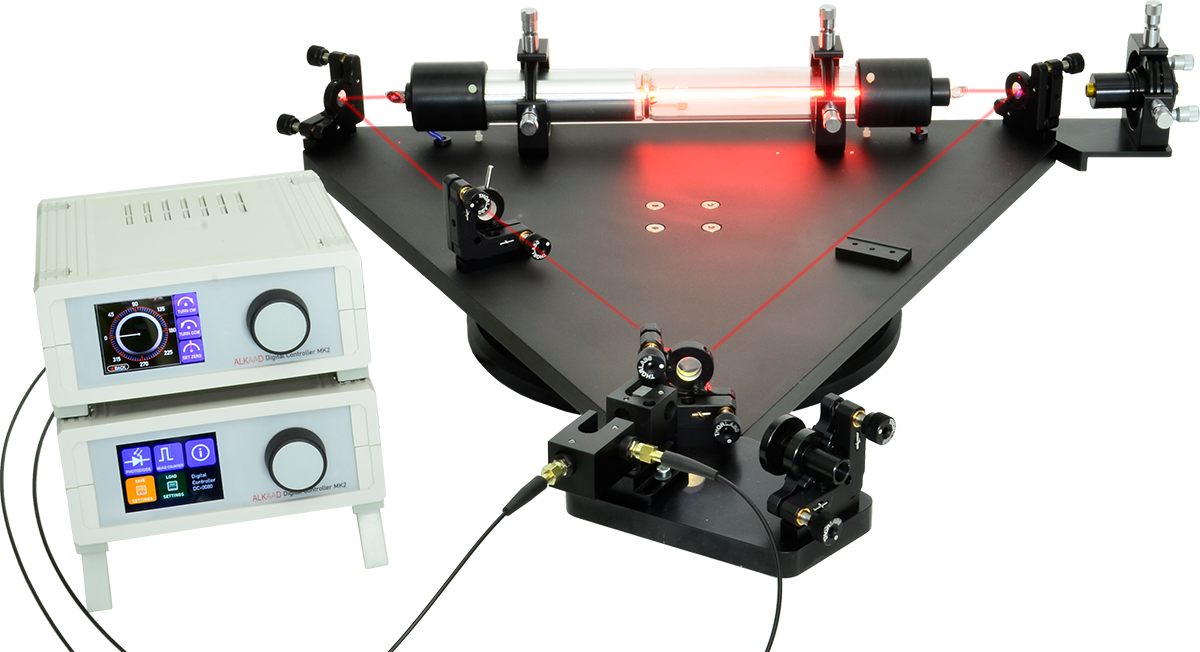- Sagnac Effect
- Interference
- Half and quarter wave plates
- HeNe Ring Laser
- Beat Frequency Detection
- Optical 90° phase shifter
- Single Mode Etalon
- Linear and Elliptical Polarization
- Direction Discrimination
- Lock-In Effect
- High Precision Angle Measurement
- Active Laser Gyroscope
- Processor Controlled Rotation
- Quad Frequency Counting
LM-0600 HeNe Laser Gyroscope
Topics:
 LM-0600 HeNe Laser Gyroscope Set-up
LM-0600 HeNe Laser Gyroscope Set-up
However the difference of such a ring laser gyroscope to the idea of Sagnac lies in the fact that within Sagnac’s set-up the light source is separate from the ring structure and the signal is as a phase shift between the counter propagating beams. In the laser gyroscope discussed and applied here, the light source is part of the ring laser and the output is a beat frequency between the counter propagating laser modes. This class of laser gyroscopes are termed as “active” and those of the Sagnac’ s type as “passive” laser gyroscopes. In general the active laser gyroscope provides a much higher precision and long term stability as against the passive ones. The precision of the laser gyro becomes more evident, when it is compared to other well known measuring devices for instance a micrometer screw with a resolution of 0.01 mm. It must have at least a length of at least 3 km (!) for having the same resolution. Within this experimental system the basics of the laser gyro are explained and practically studied at the system, which allows full access to all components. The experimental laser gyroscope consists of a rugged turntable on which the ring laser is mounted. A rotational stage driven by a stepper motor which rotates the turntable. The angular speed and range can be set via the provided controller. The ring laser consists of three laser mirrors arranged at the corners of an equilateral triangle. The point of rotation lies well within the center of this triangle. At one mirror a beam bending device is positioned in such a way that the clockwise and counter clockwise propagating modes are superimposed and their beat frequency is detected by means of two photo detectors. The signal of the photodetector has a phase shift of 90° to each other so that a subsequent direction discrimination is performed. The created TTL signal is fed to a frequency counter. For the first alignment of the ring laser an adjustable green laser pointer is used. Once the system is aligned, the single mode etalon is inserted to obtain the required single mode operation. The beat frequency of the modes is measured as function of the angular speed. A special measurement is focused on the so called lock-in threshold, which is an unwanted effect of active laser gyroscopes.
| Item | Code | Qty. | Description |
|---|---|---|---|
| 1 | CA-0080 | 1 | Optics cleaning set |
| 2 | DC-0064 | 1 | High voltage supply 6.5 mA |
| 3 | DC-0080 | 1 | Quad counter & 2 channel photodiode amplifier |
| 4 | DC-0100 | 1 | Stepper motor controller |
| 5 | MM-0700 | 1 | Turntable drive unit |
| 6 | OM-0700 | 1 | Gyroscope turntable |
| 7 | OM-0720 | 1 | Alignment laser 532 nm with power supply |
| 8 | OM-0780 | 1 | Dual beat frequency detector |
| 9 | UM-LM06 | 1 | Manual HeNe laser gyroscope |
| Option (order separately) | |||
| 10 | CA-0200 | 1 | Oscilloscope 100 MHz digital, two channel |